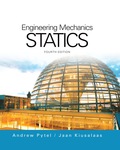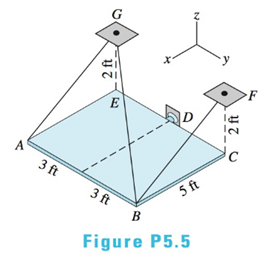
International Edition---engineering Mechanics: Statics 4th Edition
4th Edition
ISBN: 9781305856240
Author: Pytel
Publisher: Cengage
expand_more
expand_more
format_list_bulleted
Concept explainers
Textbook Question
Chapter 5, Problem 5.5P
The homogeneous plate of weight W is supported by a ball-and-socket joint at D and three wires. Draw the FBD of the plate and count the unknowns.

Expert Solution & Answer
Trending nowThis is a popular solution!

Students have asked these similar questions
y(0)=1,
Using Laplace transforms solve the following differential
equations :
11) y"-4y+4y=0,
12) y+2y+2y=0,
y(0)=2.1,
y'(0) = 3.9
y'(0)=-3.
13) y+7y+12y=21e",
y(0)=3.5,
y'(0)=-10.
14) +9y=10e.
y(0)=0,
y'(0) = 0.
15) y+3y+2.25y=91³ +64,
y(0)=1,
y'(0) = 31.5
16) -6y+5y= 29 cos(21),
y(0)=3.2,
y'(0)=6.2
17) "+2y+2y=0,
y(0)=0,
y'(0)=1.
18) +2y+17y=0,
y(0)=0,
y'(0)=12.
19) y-4y+5y=0,
y(0)=1,
y'(0) = 2.
20) 9y-6y+y=0,
y(0)=3,
y'(0)=1.
21) -2y+10y=0,
y(0)=3,
y'(0)=3.
4. Consider the rectangulan
2535
Let
16
a
and
section discussed
977b
+
class.
in
ie make a
M
thin"
rectangle, Can you
you show that
Q = Go {a² = x² } .
Imax =
2 Ga
ты
J =
1. Consider a
circular shaft in torsion
that
of radius r=b
has a key way
as shown,
circle of
radius a
Let us try the solution
x₁
(5,0) = k (6² = r²) (1- 2 awso
1.1 Does this solve the problem for the
stres rer
1,2 Solve for
is and 23.
Chapter 5 Solutions
International Edition---engineering Mechanics: Statics 4th Edition
Ch. 5 - Bar AB of negligible weight is supported by a...Ch. 5 - Draw the FBD for the bar described in Prob. 5.1 if...Ch. 5 - The space truss ABCD in the shape of a tetrahedron...Ch. 5 - Draw the FBD of the portion BCD of the space truss...Ch. 5 - The homogeneous plate of weight W is supported by...Ch. 5 - The bar ABCD of negligible weight is supported by...Ch. 5 - The shaft-pulley assembly is supported by the...Ch. 5 - The 60-lb homogeneous door is supported by hinges...Ch. 5 - Draw the FBD for bar BCD. The connections at A and...Ch. 5 - The homogeneous 360-lb plate with a rectangular...
Ch. 5 - The L-shaped rod, supported by slider bearings at...Ch. 5 - The homogeneous 240-lb bar is supported by a rough...Ch. 5 - In Sample Problem 5.4, determine the tension TAC...Ch. 5 - In Sample Problem 5.5, compute the tension TAD...Ch. 5 - In Sample Problem 5.5, determine Oy with one...Ch. 5 - Determine the tension TB in Sample Problem 5.6...Ch. 5 - Compute the tension TAE in Sample Problem 5.7...Ch. 5 - The 80-lb homogeneous plate is suspended from four...Ch. 5 - The three bars are welded together to form a rigid...Ch. 5 - The compound bar is supported by a thrust bearing...Ch. 5 - The homogeneous 20-kg door is held in the...Ch. 5 - The light boom AB is attached to the vertical wall...Ch. 5 - The homogeneous 80-kg sign is suspended from a...Ch. 5 - The bar ABC is supported by a ball-and-socket at A...Ch. 5 - Determine the forces in members PAE,PAF, and PBG...Ch. 5 - The figure shows the FBD of a portion of the space...Ch. 5 - Calculate all forces acting on the bar AB...Ch. 5 - Determine the forces in members AD, BD, and CD of...Ch. 5 - Find the tension in cable BE that supports the bar...Ch. 5 - For the structure in Prob. 5.9, determine the...Ch. 5 - Calculate the reaction at D for the structure...Ch. 5 - Calculate the reaction at D for the structure...Ch. 5 - Determine the tension in each of the three ropes...Ch. 5 - Using only one equilibrium equation, compute the...Ch. 5 - The homogeneous 25-kg bar AB is supported by a...Ch. 5 - The shaft AB is supported by a thrust bearing at A...Ch. 5 - The bar ABCD has a built-in support at A....Ch. 5 - The total weight of the L-shaped beam of constant...Ch. 5 - The bent rod of negligible weight is supported by...Ch. 5 - A 120-lb weight is attached to the cable that is...Ch. 5 - Calculate the force in cable CD and the reaction...Ch. 5 - The 350-lb homogeneous plate has the shape of an...Ch. 5 - The bent rod ABCD is supported by a...Ch. 5 - A hoist is formed by connecting bars BD and BE to...Ch. 5 - The crank arm OD of the winch is connected by a...Ch. 5 - The 80-lb homogeneous plate is supported by a...Ch. 5 - The frame is built into the wall at D and G. The...Ch. 5 - The bent bar of negligible weight is supported by...Ch. 5 - Determine the reactions at ball-and-socket joints...Ch. 5 - The 180-lb homogeneous bar is supported by a...Ch. 5 - The bent rod is supported by a ball-and-socket...Ch. 5 - Find the maximum load P that can be supported by...Ch. 5 - The vertical mast OA, which weighs 1.5 kN, is...Ch. 5 - The homogeneous bar AB weighs 50-lb. End B leans...Ch. 5 - The 500-kg crate is supported by the three cables....Ch. 5 - The uniform bars AB and BC each weigh 4 lb/ft....Ch. 5 - The rigid body of negligible weight is supported...Ch. 5 - The homogeneous 860-kg bar AB is supported by a...Ch. 5 - The triangular plate is supported by three...Ch. 5 - The connections at the ends of bars AB and BC arc...Ch. 5 - The bar AEB is supported by a ball-and-socket...Ch. 5 - The shaft is supported by a thrust bearing at A...
Knowledge Booster
Learn more about
Need a deep-dive on the concept behind this application? Look no further. Learn more about this topic, mechanical-engineering and related others by exploring similar questions and additional content below.Similar questions
- 3. - a For an elliptical cross that the tangent to section resultant shear can you s stress is show ellipse with the same 24 i ratio of eccentricity, in passes through to point alb that in question, it + Parrow_forward2. Consider the rod with an elliptical that strain 4 a Cross secton considered in class, Integrate the was displacement displacements, relations to obtain thearrow_forwardPlease answer Oxygen at 300 kPa and 90°C flowing at an average velocity of 3 m/s is expanded in an adiabatic nozzle. What is the maximum velocity of the oxygen at the outlet of this nozzle when the outlet pressure is 60 kPa? Use the table containing the ideal gas specific heats of various common gases. The maximum velocity of the oxygen at the outlet of this nozzle is 532.5 Numeric ResponseEdit Unavailable. 532.5 incorrect.m/s.arrow_forward
- A container filled with 70 kg of liquid water at 95°C is placed in a 90-m3 room that is initially at 12°C. Thermal equilibrium is established after a while as a result of heat transfer between the water and the air in the room. Assume the room is at the sea level, well sealed, and heavily insulated. NOTE: This is a multi-part question. Once an answer is submitted, you will be unable to return to this part. Determine the amount of heat transfer between the water and the air in the room. The amount of heat transfer between the water and the air in the room is kJ.arrow_forwardA strain gauge rosette that is attached to the surface of a stressed component gives 3 readings (ɛa = A, b = B, &c = C). If the strain gauge rosette is of the D° type (indicating the angle between each of the gauges), construct a Mohr's Strain Circle overleaf. You should assume that gauge A is aligned along the x-axis. Using the Mohr's Strain Circle calculate the: (i) principal strains (ε1, 2)? (ii) principal angles (1, 2)? You should measure these anticlockwise from the y-axis. (iii) maximum shear strain in the plane (ymax)?arrow_forwardQ1. If the yield stress (σy) of a material is 375MPa, determine whether yield is predicted for the stresses acting on both the elements shown below using: (a) Tresca Criterion (b) Von Mises Criterion P Element A R S Element B Note: your values for P (vertical load on Element A) should be negative (i.e. corresponding to a compressive vertical load).arrow_forward
- Q. After a puncture a driver is attempting to remove a wheel nut by applying a force of P KN to one end of a wheel brace as shown in Fig. 1. In cross-section the brace is a hollow steel tube (see section aa) of internal diameter r mm and external diameter q mm. wheel nut n Position S P m r q Section aa Fig, 1 (a) Calculate (i) the twisting moment, (ii) the bending moment, and (iii) the shear force in the brace at position S due to the applied load P. (b) Calculate (i) the shear stress due to twisting, and (ii) the bending stress at position S. Note that the shear force will not produce any shear stress at S. (c) Calculate the maximum shearing stress in the brace at position S using the Maximum Shear Stress Criterion. 2 Mechanics of Materials 2 Tutorials Portfolio: Exercise 5 (d) If the maximum permissible shear stress in the steel is 200 MPa, determine the maximum torque that can be applied by the brace without the risk of failure at S.arrow_forwardCalculate the first 5 Fourier series coefficients (A0-4 and B1-5 ) for the estimated R wave.arrow_forwardRefrigerant-134a is expanded isentropically from 600 kPa and 70°C at the inlet of a steady-flow turbine to 100 kPa at the outlet. The outlet area is 1 m2, and the inlet area is 0.5 m2. Calculate the inlet and outlet velocities when the mass flow rate is 0.65 kg/s. Use the tables for R-134a. The inlet velocity is m/s. The outlet velocity is m/s.arrow_forward
- A container filled with 70 kg of liquid water at 95°C is placed in a 90-m3 room that is initially at 12°C. Thermal equilibrium is established after a while as a result of heat transfer between the water and the air in the room. Assume the room is at the sea level, well sealed, and heavily insulated. NOTE: This is a multi-part question. Once an answer is submitted, you will be unable to return to this part. Determine the final equilibrium temperature. Use the table containing the ideal gas specific heats of various common gases. The final equilibrium temperature is °C.arrow_forwardSteam at 100 psia and 650°F is expanded adiabatically in a closed system to 10 psia. Determine the work produced, in Btu/lbm, and the final temperature of steam for an isentropic expansion efficiency of 80 percent. Use steam tables. The work produced is Btu/lbm. The final temperature of steam is °F.arrow_forwardComplet the solution : Vavg Ti Te Ts Q hexp Nuexp htheo Re Nutheo Error (m/s) (*C) (*C) (*C) (W) 2.11 18.8 21.3 45.8 2.61 18.5 20.8 46.3arrow_forward
arrow_back_ios
SEE MORE QUESTIONS
arrow_forward_ios
Recommended textbooks for you
 International Edition---engineering Mechanics: St...Mechanical EngineeringISBN:9781305501607Author:Andrew Pytel And Jaan KiusalaasPublisher:CENGAGE L
International Edition---engineering Mechanics: St...Mechanical EngineeringISBN:9781305501607Author:Andrew Pytel And Jaan KiusalaasPublisher:CENGAGE L

International Edition---engineering Mechanics: St...
Mechanical Engineering
ISBN:9781305501607
Author:Andrew Pytel And Jaan Kiusalaas
Publisher:CENGAGE L
EVERYTHING on Axial Loading Normal Stress in 10 MINUTES - Mechanics of Materials; Author: Less Boring Lectures;https://www.youtube.com/watch?v=jQ-fNqZWrNg;License: Standard YouTube License, CC-BY